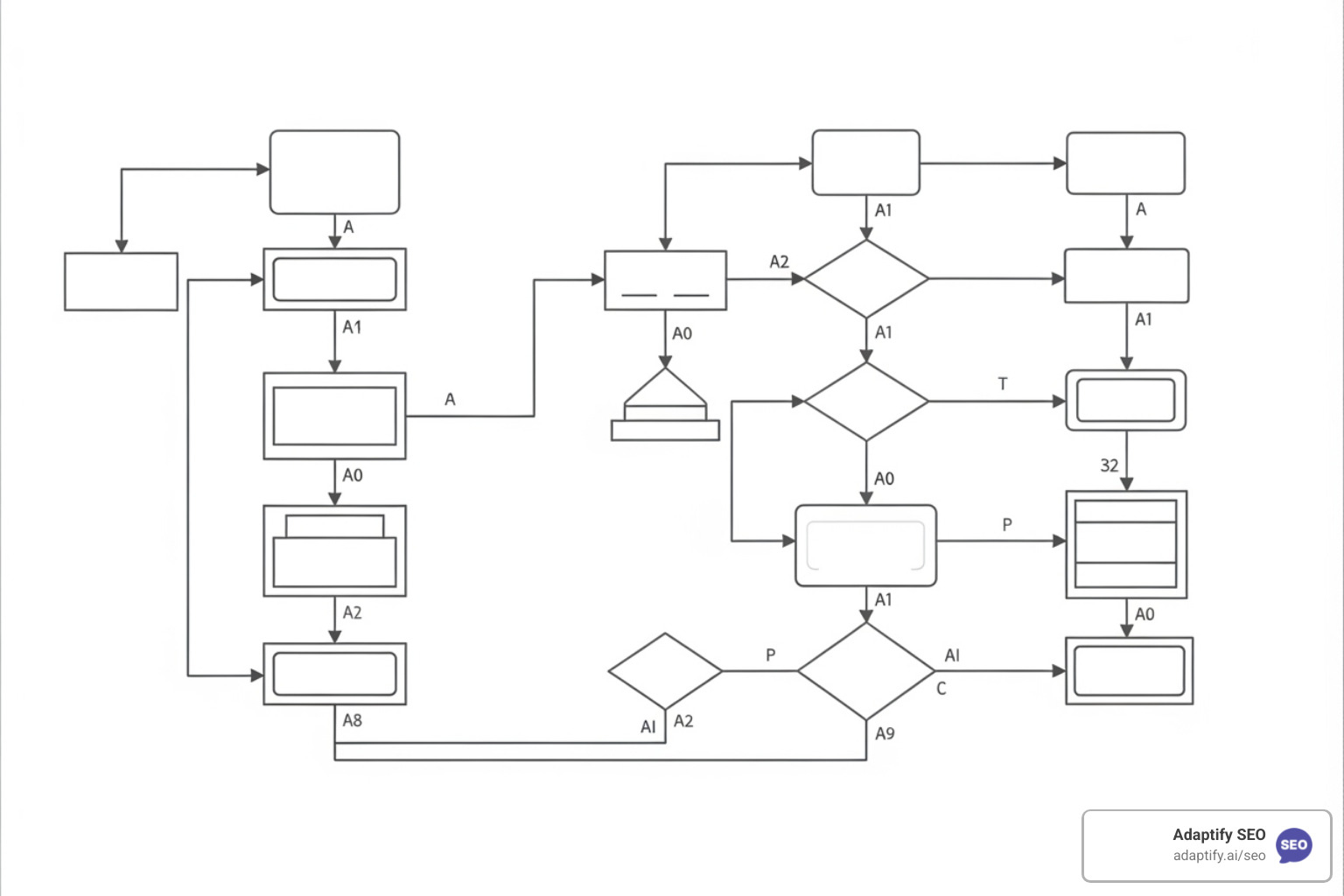Beyond the Buzz: How to Formulate a Winning AI Strategy
Hansjan Kamerling
Jul 28
Why AI Strategy Formulation Demands Your Immediate Attention

AI strategy formulation is the systematic process of integrating artificial intelligence into your organization's core business operations to drive competitive advantage. Here's what successful AI strategy formulation involves:
Key Components:
- Vision Definition - Align AI goals with business objectives
- Readiness Assessment - Evaluate data, infrastructure, and skills
- Opportunity Identification - Prioritize high-impact AI use cases
- Implementation Roadmap - Create phased rollout plans with clear milestones
- Governance Framework - Establish ethical guidelines and risk management
Despite AI's transformative potential, most organizations struggle with implementation. Only 40% of companies have an enterprise-wide AI strategy in place, while 66% view AI as critical to success. This gap represents both a challenge and an opportunity.
The stakes couldn't be higher. As Andrew Ng warned: "In the past, many CEOs of the S&P 500 wished they had started thinking about their internet strategy earlier than they did. I think in five years, there will be some CEOs in the S&P 500 who will wish they had started thinking about their AI strategy earlier."
The difference between organizations that thrive with AI and those that struggle isn't access to technology - it's having a clear, systematic approach to AI strategy formulation. Companies with well-communicated AI visions are 1.5 times more likely to achieve their desired outcomes compared to those without strategic direction.
I'm Hansjan Kamerling. With years of experience helping AI startups and SaaS platforms steer digital change—including leading product design for data analytics platforms serving 40,000+ users—I've seen how a strategic approach to AI strategy formulation separates successful AI adoption from costly failures across various sectors.
Why an AI Strategy is Your New Competitive Imperative
AI strategy formulation is your roadmap for staying relevant. It's not just about buying the latest tools; it's a blueprint for weaving AI into the fabric of your business. A true AI strategy transforms how you make decisions and operate, using machine learning and automation to boost operational efficiency, drive transformative growth, and create competitive differentiation.
Here's what makes this urgent: According to a Deloitte survey, organizations with a clear, communicated AI vision are 1.5 times as likely to achieve desired outcomes. That's not a small edge—that's the difference between thriving and merely surviving.

Aligning AI with Overarching Business Goals
Many companies treat AI as a shiny new toy instead of a mission multiplier for their core business strategy. The strongest AI strategies don't start by talking about algorithms; they start with a simple question: "What are we trying to achieve as a business?"
"The strongest AI strategies tend to begin without ever mentioning AI, instead starting with the organization's core business strategy." This approach ensures every AI initiative directly supports your company's mission and creates real value creation.
Smart organizations focus on growth-oriented goals rather than just cutting costs. While efficiency-focused AI goals like automating workflows are important, the real winners pursue cost-out goals alongside transformative opportunities.
| Efficiency-Focused AI Goals | Growth-Focused AI Goals |
|---|---|
| Automate repetitive workflows | Create new products and services |
| Reduce operational costs | Enter new markets |
| Improve internal process efficiency | Improve customer satisfaction |
| Optimize resource allocation | Drive revenue growth and market share |
The key is treating AI as fuel for your existing business strategy, not as a separate project in the IT department. When done right, AI becomes the engine that powers better customer experiences, stronger supply chains, and entirely new business opportunities.
The Risk of Inaction in the Age of AI
A sobering reality check: only 38% of businesses believe their use of AI differentiates them from competitors. This means most companies are not using AI strategically or are doing the same things as everyone else.
The technology adoption gap is creating a dangerous strategic disadvantage for companies that wait. As Marco Iansiti and Karim Lakhani point out: "Over the last decade, we saw the emergence of firms that are designed and architected to release the full potential of data, algorithms, and AI."
These AI-native companies aren't just using technology differently—they're fundamentally restructuring how business gets done. They're not retrofitting AI onto old processes; they're building entirely new ways of creating value. This strategic shift is why major consulting firms like McKinsey & Company and Boston Consulting Group (BCG) have built robust AI practices, guiding large enterprises through this change. They help legacy companies compete with AI-natives, but their large-scale, high-cost engagements highlight a critical market gap for more accessible, specialized solutions.
The market relevance question isn't whether AI will transform your industry, but whether you'll lead that change or get left behind. Companies without a clear AI strategy formulation process aren't just standing still—they're actively losing ground.
At Adaptify.ai, we see this competitive advantage play out daily. Our automated SEO platform doesn't just make existing processes faster; it fundamentally changes how agencies approach content strategy and link building. Explore our case studies to see how automation drives results and creates real competitive differentiation.
The window for strategic AI adoption is closing fast. The question isn't whether you can afford to invest in AI strategy formulation—it's whether you can afford not to.
The 5-Phase Framework for AI Strategy Formulation
A successful AI strategy formulation process requires a thoughtful, systematic approach. The most effective strategies follow a clear framework rather than jumping straight to the latest AI tools. Like building a house, you need a solid foundation and a clear blueprint. This five-phase framework provides a structured path from vision to implementation.

Phase 1: Define Your Vision and Assess AI Readiness
Before charting a course, you must know your destination and starting point. This phase is about honest assessment and clear vision setting. Start by defining success: what specific business outcomes will AI drive? Whether it's reducing customer service response times or improving sales forecasts, the key is connecting AI goals directly to your broader business strategy.
Next comes the reality check. We dive into your current AI readiness through an "AI-first scorecard," covering everything from your data infrastructure to your team's technical skills.
The data audit is particularly revealing, often uncovering data silos, inconsistent data quality, or governance gaps that complicate progress.
We also assess your team's current capabilities. Do you have data scientists? How comfortable are your employees with new technology? As Jen Stave put it: "It's just understanding the business literature... Understanding business strategy, understanding all the core components of business is the foundation you need before you can even think about how to apply AI."
This foundational work is critical. You can listen to the full episode for more insights on building this strong foundation.
Phase 2: Identify and Prioritize High-Impact AI Opportunities
Next, brainstorm how AI could transform your business. To avoid getting overwhelmed, use both top-down strategic thinking and bottom-up practical insights.
I facilitate workshops with cross-functional teams to identify potential AI use cases, from marketing's desire for content automation to operations' ideas for supply chain optimization.
These opportunities fall into two categories: Operational efficiency improvements (quick wins that build momentum) and Transformative growth initiatives (bigger bets that create new products or markets).
To make sense of these possibilities, I use a value versus feasibility matrix. High-value, high-feasibility projects become immediate priorities. High-value, low-feasibility ideas are long-term strategic bets. Low-value initiatives are shelved.
When evaluating each opportunity, I ask four critical questions: How does this support our top business objectives? How quickly can we drive value? How accessible and trustworthy is the data? Is AI the right fit for this problem? That last question is crucial—sometimes a simpler solution is more effective.
Phase 3: Build a Realistic and Agile Implementation Roadmap
With clear priorities, it's time to create a practical, adaptable roadmap. Too many strategy documents are created only to gather dust.
My approach is to start small and build momentum with pilot projects. As Rita McGrath wisely noted: "Instead of launching it like a great big bang and running the risk of some massive public failure, you do it one findy at a time." You can explore more about this gradual approach in the HBR IdeaCast episode on digital change.
Every effective roadmap addresses three critical areas: Data strategy (how you'll collect and govern information), Algorithm selection (choosing the right AI techniques), and Infrastructure planning (the technical backbone, like cloud vs. on-premise solutions).
The roadmap isn't set in stone. Technology evolves and priorities shift, so I build in regular review points to maintain flexibility and adjust course when needed.
Phase 4: Establish a Robust Governance and Ethical Framework
As AI becomes integral to your operations, you need robust guardrails for responsible implementation. This isn't just about avoiding bad press; it's about building sustainable, trustworthy AI systems.
Data privacy is non-negotiable, with regulations like GDPR and CCPA setting clear standards. Algorithmic bias is equally critical, as models can amplify existing biases and lead to unfair outcomes.
Transparency and accountability are essential for maintaining trust. Stakeholders need to understand how AI-driven decisions are made, especially for high-stakes applications.
Staying ahead of regulatory compliance is also crucial. The landscape is evolving, with initiatives like the UK and US partnership on AI safety shaping future requirements. Frameworks like Gartner's AI TRiSM (Trust, Risk, and Security Management) provide excellent guidance.

Phase 5: Assemble the Team and Foster an AI-Ready Culture
Technology is only half the equation; people are the other, often more challenging, half. As the old saying goes: "Culture eats strategy for breakfast."
Successful AI strategy formulation requires a cross-functional team: a C-suite champion, business unit leaders, data scientists, IT experts, and legal and compliance members.
Don't forget HR and training professionals to manage the human side of AI adoption. AI will change how people work, and that can be scary.
The key is transparent communication. Frame AI as augmentation, not replacement—giving your team "superpowers" for higher-value work. Invest heavily in upskilling and reskilling programs. When employees see a path for growth, they become advocates for change.
Building an AI-ready culture takes time. It's about creating an environment where experimentation is encouraged, failure is a learning opportunity, and continuous adaptation is the norm. This cultural foundation often determines whether your AI strategy succeeds or stalls.
Navigating Implementation: Challenges, Measurement, and Adaptation
Successfully implementing an AI strategy is where the rubber meets the road. It's an execution game that requires continuous monitoring, risk mitigation, and a willingness to adapt.
Mitigating Common Roadblocks in AI Strategy Formulation
Many organizations stumble during implementation due to predictable pitfalls. Here are the most common roadblocks and how to tackle them:
- Insufficient Data Quality: AI models are only as good as the data they're fed. If your data is messy, incomplete, or siloed, your AI initiatives will struggle.
- Mitigation: Invest in robust data governance, cleansing, and integration. At Adaptify.ai, we know high-quality data is the foundation for our automated SEO tools.
- Lack of AI Knowledge: A lack of understanding about AI's capabilities across the organization can lead to unrealistic expectations or missed opportunities.
- Mitigation: Provide ongoing education and training for all levels, from executives to front-line employees.
- Misalignment of Strategy: When AI projects aren't clearly tied to business goals, they often fail to deliver tangible value.
- Mitigation: Reiterate the business objectives for every AI initiative and ensure regular communication between technical and business teams.
- Scarcity of Talent: A global shortage of skilled AI professionals can hinder development.
- Mitigation: Focus on upskilling existing employees and strategically recruit for critical roles. Another powerful approach is to leverage automated machine learning (AutoML) platforms like DataRobot or H2O.ai, which empower existing teams to build and deploy AI models without deep data science expertise.
- Integration Complexities: Integrating new AI systems with legacy IT infrastructure can be difficult.
- Mitigation: Plan for integration from the start, prioritizing solutions with robust APIs.
- Resistance to Change: Employees may fear job displacement or resist new ways of working.
- Mitigation: Communicate clearly about AI's benefits, emphasizing augmentation over replacement. Involve employees in the process and offer training.
My experience shows that addressing these challenges proactively increases your chances of success. For example, understanding how AI can automate complex SEO content strategies can help overcome the talent gap for marketing agencies.
Measuring Success and Ensuring an Adaptable AI Strategy
How should you measure an AI strategy's success and keep it adaptable? Many organizations falter here. A Gartner survey shows that mature AI adopters measure success by business impact, not project volume or output.
My approach is to anchor success measurement to tangible business outcomes:
- Business Impact: Are we seeing increased revenue, improved customer satisfaction, or significant cost savings? High-achievers emphasize growth and customer-centric outcomes.
- KPIs: Define clear, measurable Key Performance Indicators (KPIs) for each AI initiative, such as conversion rates, customer churn reduction, or efficiency gains.
- Benchmarking: Benchmark your AI performance internally (against previous periods) and externally (against competitors).
- Involvement: Organizations where the AI team helps define success metrics are 50% more likely to use AI strategically.
Finally, an AI strategy must be dynamic. Technology and markets evolve rapidly, so:
- Iterative Process: Treat your strategy as a living document, subject to continuous review.
- Feedback Loops: Establish strong feedback loops from deployed AI systems to inform future iterations.
- Perpetual Iteration: As Tsedal Neeley of Harvard Business School put it, "There’s no such thing as, ‘OK, we’re changing, we’ve changed, we’re done.’ No. Technology changes... So you’re entering a perpetually liminal state." This mindset is crucial for long-term success.
Measuring success isn't just about validating past efforts; it's about providing the insights needed to pivot and ensure your AI strategy continues to deliver a competitive advantage. To understand the potential ROI for your agency, I suggest you See our pricing and ROI calculator to gauge the impact of automated SEO.
Frequently Asked Questions about AI Strategy Formulation
Who should be involved in creating an AI strategy?
Creating an AI strategy requires a cross-functional team. Key roles include:
- Executive Champions (CEO, CTO, CDO): To set the vision, secure budgets, and ensure enterprise-wide support.
- Business Unit Leaders: To identify practical, high-impact use cases grounded in daily operations.
- IT and Data Science Teams: To assess technical feasibility, infrastructure, and data quality.
- Legal and Compliance: To steer risk, governance, and regulatory requirements from the start.
- HR and Training: To manage the human side of change and lead upskilling efforts.
My experience suggests an external AI expert can also provide unbiased insights and accelerate the process.
How is an AI strategy different from a general IT or digital change strategy?
While related, an AI strategy is more transformative. A digital change strategy builds the foundation—moving to the cloud or digitizing records. It's about becoming efficient. An AI strategy uses that foundation to build intelligence, creating predictive and automated capabilities that change how decisions are made.
Think of it this way: a digital strategy builds the highway, while an AI strategy designs the self-driving cars that revolutionize travel on it. The former gets you connected; the latter makes you intelligent. For example, a digital strategy digitizes customer records. An AI strategy uses that data to predict customer issues and automate personalized responses.
How often should an AI strategy be reviewed and updated?
An AI strategy can't be a static five-year plan; the field moves too fast. Treat it as a living document with a regular review cadence:
- Annual Formal Reviews: For comprehensive overhauls. Reassess AI maturity, evaluate major tech shifts, and pivot your overall approach.
- Quarterly Check-ins: To stay agile. Focus on roadmap progress, KPIs, and tactical adjustments to accelerate successes or reprioritize based on market changes.
The goal is to remain dynamic and responsive. Triggers for an unscheduled review could include major competitor moves, new technologies, or regulatory changes. The companies that succeed with AI iterate continuously.
Conclusion
A successful AI strategy formulation isn't about chasing tech trends; it's about asking, "How can this technology solve our biggest business challenges?"
Throughout this guide, we've walked through the five essential phases: setting a clear vision, assessing your readiness, prioritizing opportunities, building realistic roadmaps, and establishing governance frameworks.
The key insight from my experience is to treat AI as a strategic enabler, not a toy. When you approach AI strategy formulation with the same rigor as any major business initiative, it stops being just an IT project and becomes an engine for sustainable growth and competitive advantage.
While many companies are still figuring out AI, those who act systematically today will lead tomorrow. The technology is ready. Are you?
At Adaptify SEO, we've seen how strategic AI implementation can transform agencies. Our platform doesn't just automate SEO tasks - it reimagines how agencies approach content strategy, link building, and client results. We believe AI should make your work more strategic and impactful, not more complicated.
Ready to see how a strategic approach to AI can revolutionize your agency's SEO capabilities? Book a Demo to find how our automated platform can become the cornerstone of your agency's growth strategy.
